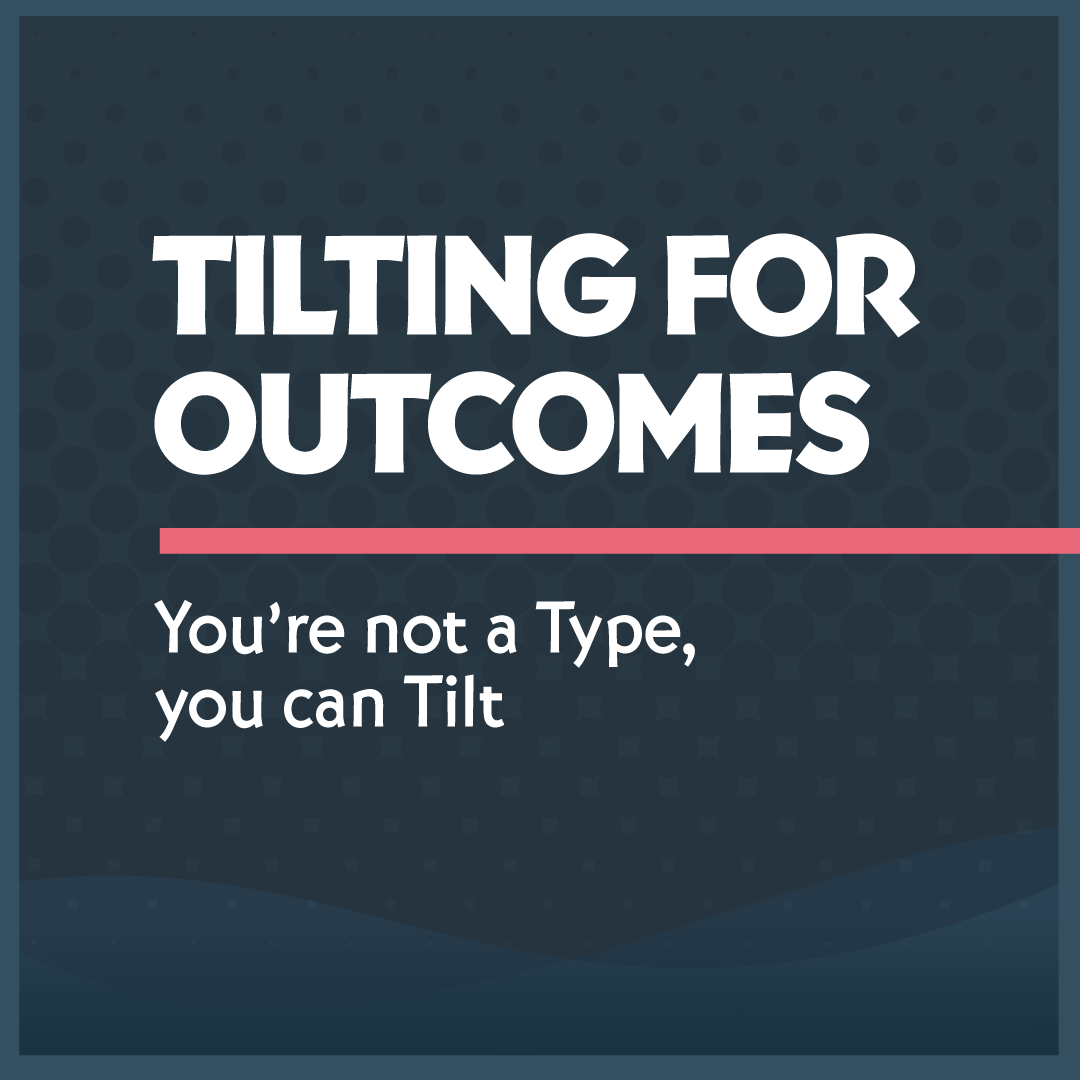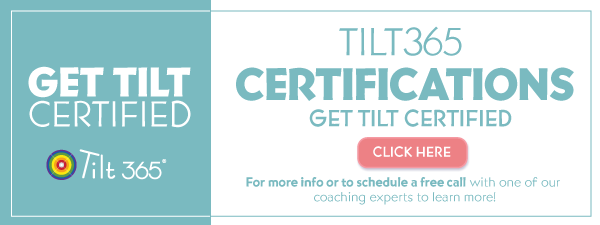Tilting for Outcomes


“You’re not a Type, you can Tilt.” This is Tilt365’s mantra, and a key reason Tilt was even created. The founder, Pam Boney, recognized that, while personality assessments are helpful in understanding our “go to” behaviors, we are not defined by our personality; instead, we grow and develop over time, and can choose how we respond to different situations. But what does it mean to “Tilt to the given context?”
To explore this, let’s take a look at the Tilt model. Have you noticed that each Tilt has a different color, and that those colors match the mindset colors (the rings in the Tilt model)? This is intentional! Each Tilt naturally aligns with a particular mindset, and even is best at that particular mindset… but it does not mean that if you have a certain True Tilt that you have the corresponding mindset. An individual’s mindset is separate from his or her True Tilt’s natural mindset. For example, if someone has a True Tilt of Structure, that does not mean they are in the protective mindset; you can have a True Tilt of Structure and have any mindset (including Agile and Generative). You can also Tilt towards Structure while holding any mindset. It does mean that the Structure True Tilt is really good at embodying the Protective mindset. Let’s look at each Tilt a bit further.

Structure
As mentioned above, Structure True Tilt is red, which corresponds with the Protective mindset. One way to remember this is that red often means “Stop!” and Structure typically starts with “no” when asked about a new idea. This comes from a good place of wanting to honor commitments already made because incorporating new ideas may mean missed deadlines. Structure therefore typically is not open to new ideas… until you can make your case with data and logic. Structure is about protection – for self, others, property, institutions, commitments, etc. Think of it this way – if you’re in an emergency, you better tilt towards Structure! Some procedures need to be executed quickly in a precise way so that lives are saved. There is no time for getting input or buy-in; there needs to be someone certain, confident, and bold in directing others to safety. If you need to execute, you need to Tilt toward Structure. For example, once project plans and commitments have been made, it’s time to stop asking for input and focus on the priorities. Another context in which Structure is helpful is in a highly regulated environment; the Protective mindset embodies a dualistic attitude, categorizing things as right or wrong.
Impact
Impact True Tilt is orange, corresponding with the Competitive mindset. The color orange comes from the competitive “fire in the belly” - bringing innovations into the world and doing it first. This is aligned with Impact’s bias for action – failing fast/failing forward is preferable to spending too much time trying to get everything right. After all, if something doesn’t work, it’s not failure but data. When those experiments result in something unexpected, considering not only what can be tweaked for the subsequent trial but also what the value is in this “happy mistake” – often leads to spin-off innovations (for example, the creation of Post-It’s from a “failed” experiment to create a super-strong glue). If you want to innovate, you need to Tilt towards Impact. For example, when faced with a new challenge, it’s time to brainstorm, experiment, and explore. Another context in which Impact is valuable is in an emerging market, where the rules and regulations lag behind what is happening in the marketplace.
Clarity
Clarity True Tilt is yellow, corresponding with the Integrative mindset. One way to remember this is that yellow is a color that signifies caution (like traffic lights and signs). Clarity’s superpower is all about managing risk - it is about getting input and seeing how everything fits together and what needs to happen in order for a vision to be achieved. In contrast to Impact, Clarity prefers to prepare before acting in order to support the best chance for success. If you want to get alignment, you need to Tilt towards Clarity. For example, when starting a new job or role, it’s helpful to analyze data and understand the people, processes, team goals, team climate, etc., and how these fit together (or don’t) before making bold moves to improve performance. Another context in which Clarity is particularly helpful is when the stakes are high, and you need to manage risk effectively.
Connection
Connection True Tilt is green, corresponding with the Adaptive mindset. Following the traffic light analogy, one way to remember this is that green means “go” - or, in Connection’s case - “yes.” Connection is genuinely interested in new ideas and in serving people, and can sometimes say “yes” too much without thinking about what needs to happen to follow through. Connection is really about collaborating with others – both sharing ideas and insights and taking input from others to build a better solution. If you want to collaborate, you need to Tilt towards Connection. For example, in complex situations where many points of view are available, Connection helps to ensure that all voices are heard, included, and integrated into any solution. Another context in which Connection is particularly helpful is in an Open Source environment, where ideas are shared and built upon freely.
Each of the mindsets and each of the Tilts serves us in certain contexts. From an organizational perspective, there are multiple layers of intentional Tilting. While the organization as a whole may Tilt in one direction, there can also be subcultures based on work focus, geography, and even key leadership. For example, startup companies often have an Impact Tilt overall culture, because they are innovating at a rapid pace. However, they may have several subcultures embedded within the organization, such as Structure in Legal/Contracting. Just like individuals are more complex than their True Tilt, organizations are, too… and teams and organizations also can choose how they want to Tilt intentionally based on what outcome they are seeking at any point in time.
Yet another similarity in applying Tilt concepts to both individuals and organizations is the idea of overusing a Tilt. In individuals, we call these the stress reactions – micromanagement for Structure, impulsivity for Impact, paralysis analysis for Clarity, and overwhelm for Connection. These are all originating from a positive intent but get overused because we are under stress and driven by some fear that has us amp up our strengths too much. In organizations or teams, stress can also cause over-Tilting. If a team over-Tilts toward Structure, there is a hyper-focus on “the Plan” and existing commitments to the point of perfection and to the detriment of input, alignment with the bigger picture, and relationships. If a team over-Tilts toward Impact, there is a dismissiveness towards dissenting points of view (even rational ones that would help mitigate risk) and an incessant drive towards action. If a team over-Tilts toward Clarity, there is a lack of confidence regarding what to do next and an over-reliance on seeking input from others and examining minute details. If a team over-Tilts towards Connection, there is a trend of overpromising and underdelivering, fueled by a lack of accountability (for self and others).
In all cases, the simple remedy for over-Tilting in one direction is to Tilt intentionally in the opposite direction. This isn’t a huge pendulum swing, but a nudge in the opposite direction. So the team that is over-Tilting towards Structure can be intentional about checking in with stakeholders and really listening to their input; the team that is over-Tilting towards Impact can be intentional about slowing down just enough to check on the data and check in with stakeholders; the team that is over-Tilting towards Clarity can be intentional about focusing on what it does know at that moment to move forward with a decision; the team that is over-Tilting towards Connection can be intentional about creating a plan with checkpoints in place to ensure forward movement with quality deliverables.
Sound complex? Well, people are complex, and joining many people in an organization adds layers to that complexity! The good news is, the Tilt model offers a framework through which you can increase awareness, notice patterns, and choose the best path to bring yourself and your team into balance, allowing for a productive, creative, and innovative workplace.
If you are interested in using any of these personality assessments for your team, click here for more information or to purchase and access these assessments. You can also email us with any questions at support@tilt365.com.




